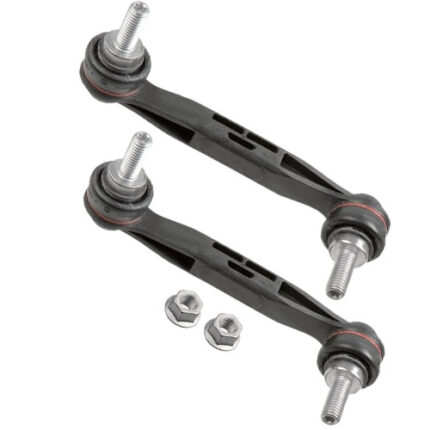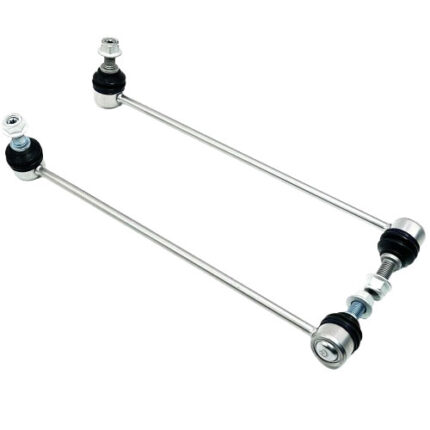-13%
Get BMW E84 X1 xDrive28i N20 2.0L Rear Sway Bar End Link RH 33506785608 in Kenya
The Rear Sway Bar End Link (Right-Hand Side) is a crucial component in a vehicle’s suspension system, particularly in enhancing stability, handling, and comfort. It connects the sway bar (also known as the anti-roll bar) to the suspension system, enabling the sway bar to perform its function effectively. This component plays a pivotal role in preventing excessive body roll and ensuring a safer driving experience, especially during sharp turns or sudden maneuvers.
Functions of the Rear Sway Bar End Link RH
- Connects the Sway Bar to the Suspension
- The end link acts as a bridge between the sway bar and the suspension control arm or strut. Without it, the sway bar would not be able to exert its force on the suspension system.
- Reduces Body Roll
- During cornering, the sway bar end link helps distribute the force between the left and right sides of the vehicle. This reduces the tendency of the body to roll excessively, improving stability.
- Enhances Handling and Control
- By maintaining the balance of the vehicle, the end link allows for better handling and steering precision, especially on uneven terrain or during abrupt turns.
- Improves Passenger Comfort
- The component helps smooth out the ride by minimizing the impact of road irregularities on the vehicle’s cabin.
Construction of the Rear Sway Bar End Link
A sway bar end link is a relatively simple yet robust component, designed to withstand continuous mechanical stress and exposure to the elements.
- Rod or Shaft
- The main body of the end link is typically made of high-strength steel or aluminum. It is designed to be lightweight yet durable, capable of withstanding heavy loads.
- Ball Joints or Bushings
- At each end of the rod, there are either ball joints or rubber/polyurethane bushings. These allow for a degree of flexibility and movement, ensuring the sway bar can adapt to changing road conditions.
- Mounting Hardware
- The end link includes bolts, nuts, and washers to securely attach it to the sway bar and suspension arm. These components are often coated to resist corrosion.
- Protective Coating
- To prevent rust and wear, the end link is typically coated with anti-corrosion materials, such as zinc or powder coating.
Benefits of the Rear Sway Bar End Link RH
- Improved Stability
- The end link ensures that the sway bar can effectively reduce body roll, keeping the vehicle stable during high-speed turns or emergency maneuvers.
- Better Handling
- By linking the sway bar to the suspension system, the end link enhances the car’s responsiveness to steering input, leading to a more enjoyable and confident driving experience.
- Prolonged Suspension Life
- Properly functioning end links help distribute forces evenly across the suspension system, reducing wear and tear on individual components.
- Enhanced Safety
- Reduced body roll and improved handling directly contribute to the overall safety of the vehicle, minimizing the risk of rollovers or loss of control.
- Cost-Effective Maintenance
- End links are relatively inexpensive compared to other suspension components. Regularly replacing worn or damaged end links can save money by preventing more extensive suspension issues.
Common Issues and Signs of Failure
Like any other mechanical component, the sway bar end link is subject to wear and tear over time. Below are some common issues and symptoms of a failing rear sway bar end link:
- Worn or Damaged Bushings/Ball Joints
- Symptoms: Clunking noises, especially when driving over bumps or during turns.
- Cause: Deterioration of rubber bushings or corrosion in ball joints due to age or exposure to road debris.
- Loose or Broken Mounting Hardware
- Symptoms: Increased body roll and reduced handling stability.
- Cause: Loose bolts or snapped hardware due to improper installation or overuse.
- Corrosion and Rust
- Symptoms: Visible rust on the rod or hardware, leading to weakened structural integrity.
- Cause: Prolonged exposure to moisture, salt, and dirt.
- Bent or Broken Rod
- Symptoms: Excessive body roll, uneven handling, and a rattling noise.
- Cause: Physical impact, such as hitting a pothole or curb.
Maintenance Tips for Rear Sway Bar End Links
- Regular Inspections
- Periodically check the end links for signs of wear, damage, or corrosion. Look for cracks in the bushings or looseness in the ball joints.
- Replace When Necessary
- Replace the end links immediately if they show signs of wear or failure. Driving with damaged end links can lead to compromised handling and increased suspension wear.
- Lubricate Ball Joints (if applicable)
- For end links with serviceable ball joints, ensure they are properly lubricated to prevent stiffness and premature wear.
- Avoid Harsh Driving Conditions
- Minimize driving on rough roads or hitting potholes at high speeds to prevent undue stress on the end links.
- Use Quality Parts
- Invest in high-quality OEM or aftermarket sway bar end links to ensure durability and performance.
- Check Alignment
- After replacing end links, have the suspension alignment checked to ensure proper geometry and performance.
Replacement Process
Replacing a rear sway bar end link is a straightforward process but requires attention to detail. Here’s a general overview:
- Lift the Vehicle
- Secure the vehicle on a lift or jack stands to gain access to the rear suspension.
- Locate the End Link
- Identify the sway bar end link on the right-hand side, connecting the sway bar to the suspension arm or strut.
- Remove the Old End Link
- Use appropriate tools to remove the bolts and nuts securing the end link. You may need to hold the ball joint with a wrench to prevent it from spinning.
- Inspect Surrounding Components
- Check the sway bar, bushings, and suspension arm for signs of wear or damage before installing the new end link.
- Install the New End Link
- Attach the new end link, ensuring all bolts and nuts are tightened to the manufacturer’s specifications. Use thread-locking compound if recommended.
- Test the Suspension
- After installation, test the suspension by gently bouncing the car or driving it on a smooth road to ensure proper functionality.
Conclusion
The Rear Sway Bar End Link RH is an indispensable part of a vehicle’s suspension system, contributing to stability, handling, and overall driving comfort. While it may seem like a small component, its role in preventing body roll and maintaining suspension alignment is significant. By understanding its functions, recognizing signs of wear, and following proper maintenance practices, drivers can ensure their vehicle remains safe, stable, and enjoyable to drive. Regular inspections and timely replacements are key to keeping the sway bar end link—and the entire suspension system—in optimal condition.
Follow us on Facebook for more parts.




Reviews
Clear filtersThere are no reviews yet.